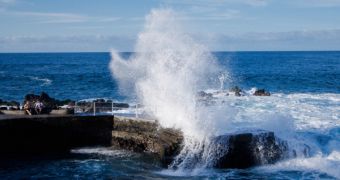Although portions of the coastline where sea and ocean waves are strong enough to generate large amounts of electricity are readily available and very wide spread, harnessing the power of the waves is not as easy as it may seem at first. Corrosion due to the salt in the water damages even the most resistant materials, and changing weather patterns affect the output that wave-powered electrical plants generate each year.
However, researchers at the Massachusetts Institute of Technology, led by Chiang Mei, a Ford Professor of Engineering in the Department of Civil and Environmental Engineering, working with professors Antonio Falcao, Antonio Sarmento, and Luis Gato, from the Insitituto Superior Tecnico at the Technical University of Lisbon, in Portugal, think that they may have found a viable way of transforming the enormous amount of potential energy in the waves into electricity.
Instead of going for a normal design for their pilot plant, the scientists advocate the use of a new and odd-looking design. The structure they envision does not have any clear opening for sea water to enter on their surface, but, rather, employs an underwater hatch, through which water enters, and then raises, due to the pressure of the waves behind it. Instead of the water operating an electrical turbine directly, it will push air upwards.
These upwards and downwards air movements will operate a specially-designed set of rotor blades, which are constructed in a manner that allows them to always spin in the same direction, regardless of how air moves around them. By adding pressure to the air, the researchers think that they could further increase the output that these power plants could generate.
And while there is little chance for the new generation of wave-powered facilities to enter usage anytime soon, all involved in the project say that the work they are doing is crucial for future generations. The main advantage that waves have over the wind and the Sun is the fact that they never stop hitting the shore lines, whereas the other two renewable energy sources can stop at any time, or be clouded, respectively.

 14 DAY TRIAL //
14 DAY TRIAL //